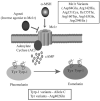Genetic determinants of cutaneous melanoma predisposition
- PMID: 21051013
- PMCID: PMC3759016
- DOI: 10.1016/j.sder.2010.06.002
Genetic determinants of cutaneous melanoma predisposition
Abstract
In the last 2 decades, advances in genomic technologies and molecular biology have accelerated the identification of multiple genetic loci that confer risk for cutaneous melanoma. The risk alleles range from rarely occurring, high-risk variants with a strong familial predisposition to low-risk to moderate-risk variants with modest melanoma association. Although the high-risk alleles are limited to the CDKN2A and CDK4 loci, the authors of recent genome-wide association studies have uncovered a set of variants in pigmentation loci that contribute to low risk. A biological validation of these new findings would provide greater understanding of the disease. In this review we describe some of the important risk loci and their association to risk of developing cutaneous melanoma and also address the current clinical challenges in CDKN2A genetic testing.
Copyright © 2010 Elsevier Inc. All rights reserved.
Figures


Similar articles
-
High- and low-penetrance cutaneous melanoma susceptibility genes.Expert Rev Anticancer Ther. 2006 May;6(5):657-70. doi: 10.1586/14737140.6.5.657. Expert Rev Anticancer Ther. 2006. PMID: 16759158 Review.
-
Molecular genetics of familial cutaneous melanoma.J Clin Oncol. 1998 Feb;16(2):670-82. doi: 10.1200/JCO.1998.16.2.670. J Clin Oncol. 1998. PMID: 9469357 Review.
-
Genetic analysis of three important genes in pigmentation and melanoma susceptibility: CDKN2A, MC1R and HERC2/OCA2.Exp Dermatol. 2010 Sep;19(9):836-44. doi: 10.1111/j.1600-0625.2010.01115.x. Epub 2010 Jul 14. Exp Dermatol. 2010. PMID: 20629734
-
Melanoma genetics: an update on risk-associated genes.Hematol Oncol Clin North Am. 2009 Jun;23(3):415-29, vii. doi: 10.1016/j.hoc.2009.03.011. Hematol Oncol Clin North Am. 2009. PMID: 19464594 Review.
-
Analysis of Latvian familial melanoma patients shows novel variants in the noncoding regions of CDKN2A and that the CDK4 mutation R24H is a founder mutation.Melanoma Res. 2013 Jun;23(3):221-6. doi: 10.1097/CMR.0b013e3283608695. Melanoma Res. 2013. PMID: 23546221
Cited by
-
Pharmacologic induction of epidermal melanin and protection against sunburn in a humanized mouse model.J Vis Exp. 2013 Sep 7;(79):50670. doi: 10.3791/50670. J Vis Exp. 2013. PMID: 24056496 Free PMC article.
-
Molecular pathology of cutaneous melanoma.Melanoma Manag. 2014 Nov;1(2):151-164. doi: 10.2217/mmt.14.23. Epub 2014 Dec 4. Melanoma Manag. 2014. PMID: 30190820 Free PMC article. Review.
-
[Ophthalmic oncology in a warmer world: climate-related increase in the prevalence of eyelid cancer].Ophthalmologie. 2025 Jan;122(1):4-11. doi: 10.1007/s00347-024-02164-9. Epub 2025 Jan 14. Ophthalmologie. 2025. PMID: 39808279 Review. German.
-
BRAF gene: From human cancers to developmental syndromes.Saudi J Biol Sci. 2015 Jul;22(4):359-73. doi: 10.1016/j.sjbs.2014.10.002. Epub 2014 Oct 23. Saudi J Biol Sci. 2015. PMID: 26150740 Free PMC article. Review.
-
Chimeric negative regulation of p14ARF and TBX1 by a t(9;22) translocation associated with melanoma, deafness, and DNA repair deficiency.Hum Mutat. 2013 Sep;34(9):1250-9. doi: 10.1002/humu.22354. Epub 2013 Jun 3. Hum Mutat. 2013. PMID: 23661601 Free PMC article.
References
-
- Jemal A, Siegel R, Ward E, et al. Cancer statistics. CA Cancer J Clin. 2009;59:225–249. - PubMed
-
- Aitken J, Welch J, Duffy D, et al. CDKN2A variants in a population-based sample of Queensland families with melanoma. J Natl Cancer Inst. 1999;91:446–452. - PubMed
-
- Lag R, Krapcho M, Stinchcomb DG, et al., editors. SEER Cancer Statistics Review, 1975–2005. National Cancer Institute; Bethesda, MD: 2008.
-
- Balch CM, Buzaid AC, Soong SJ, et al. Final version of the American Joint Committee on Cancer staging system for cutaneous melanoma. J Clin Oncol. 2001;19:3635–3648. - PubMed
Publication types
MeSH terms
Grants and funding
LinkOut - more resources
Full Text Sources
Medical
Miscellaneous
